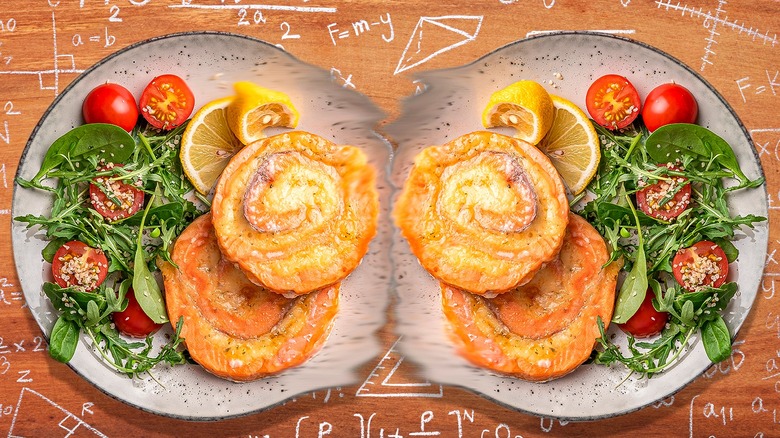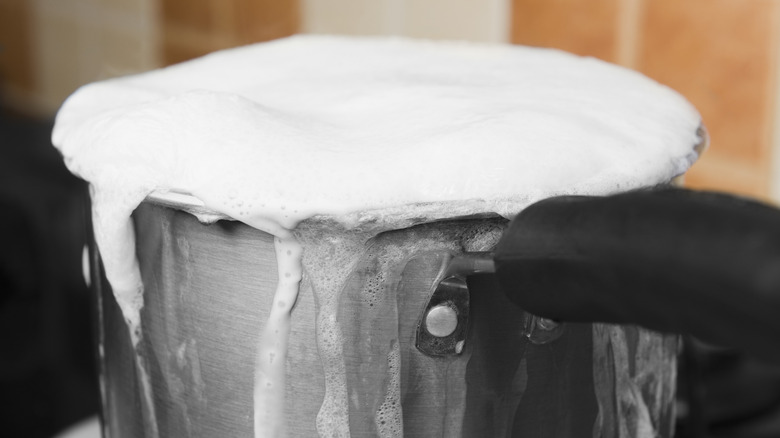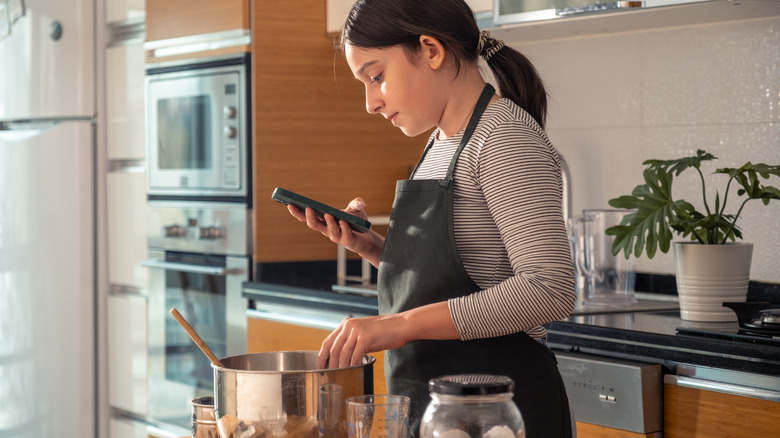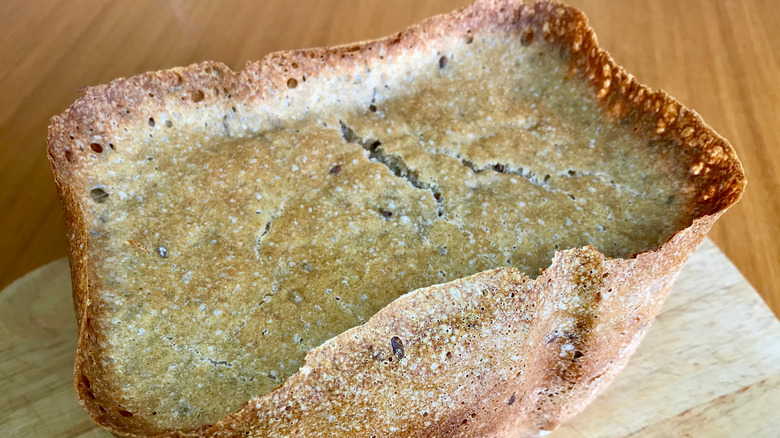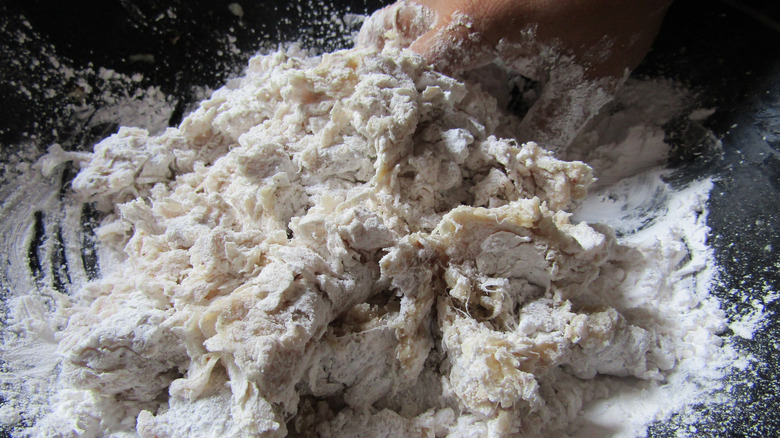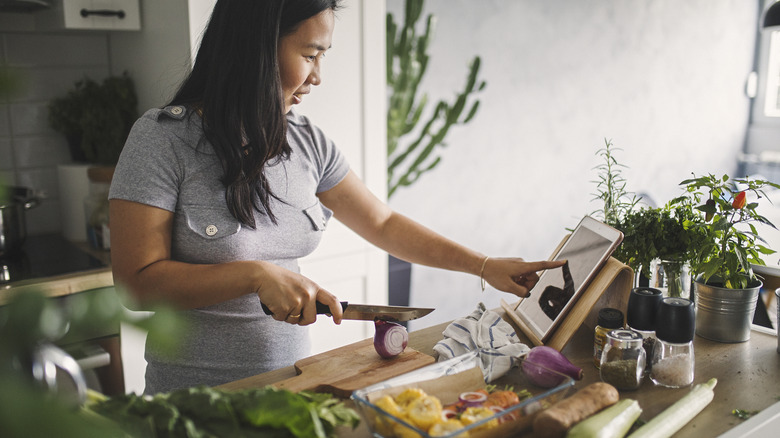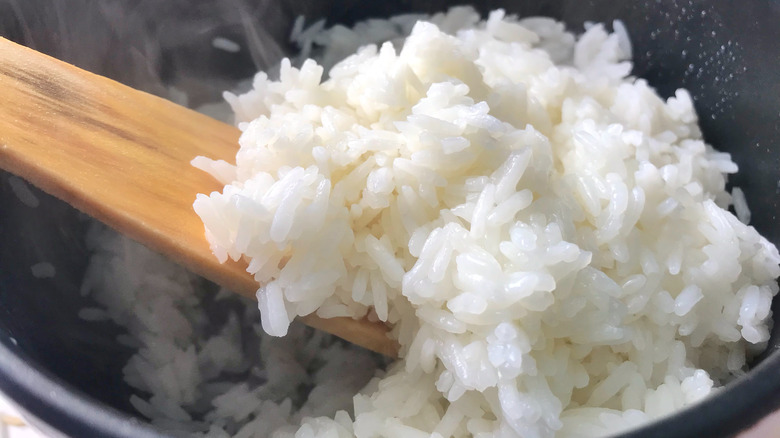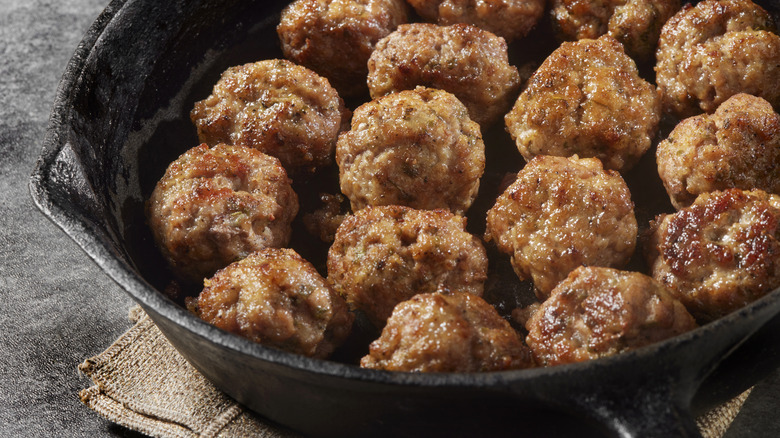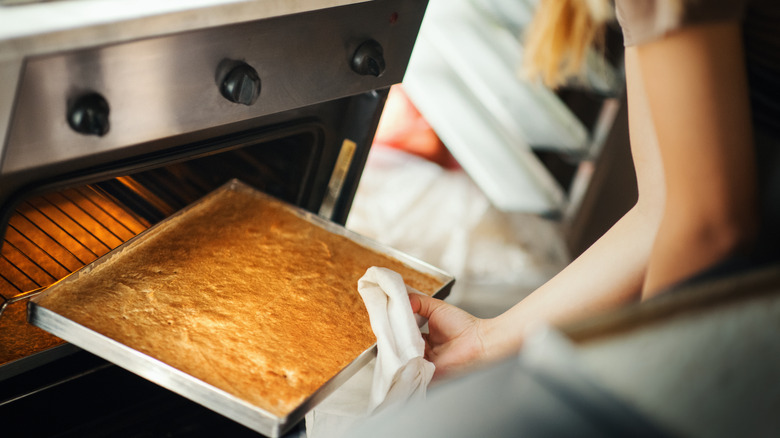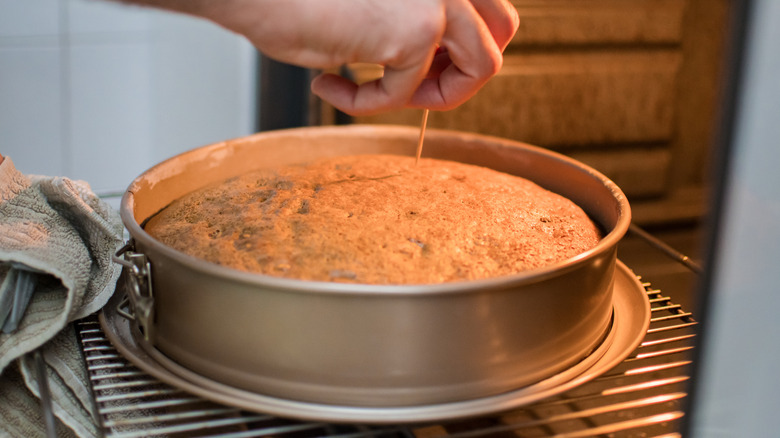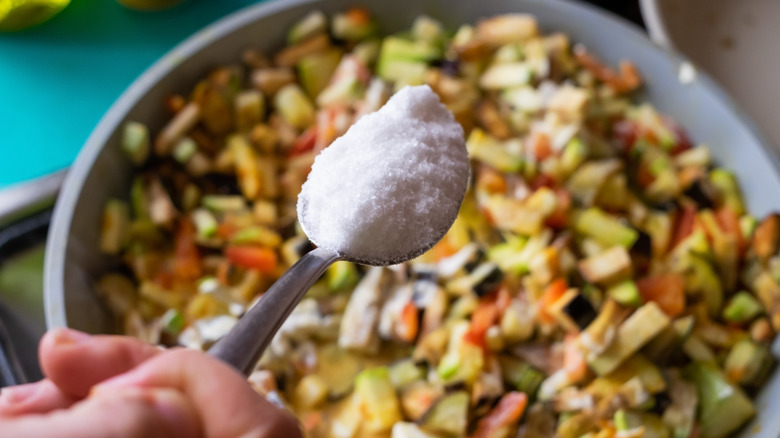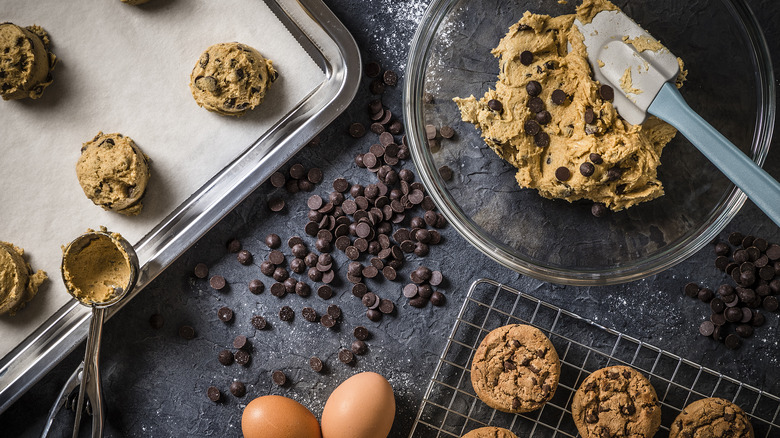11 Things To Know Before You Double A Recipe
When you're a new cook or baker, just trying your wings, it's a great day when you find a recipe that reliably turns out well. But what happens when you want to make a bigger batch or serve more guests?
The easiest starting point is to double a recipe, because doubling your ingredients is pretty straightforward math. You won't need to get into any complicated fractions or need to know how the different measurements relate to each other (though we've got you covered for common measurements, if you need us). In a pinch you could just look at the recipe as written, and measure everything twice.
Unfortunately, it's not that simple. Doubling the recipe, ingredient by ingredient, doesn't always work out for a number of reasons that are hard to foresee. As a trained chef, former restaurateur, and sometimes commercial baker (with 40-odd years' experience as a home cook and baker), I've learned many of those lessons the hard way. Here are a few of the things you should know and consider before you start.
Your pots and pans may not be able to handle it
One of the first things you need to think about is the capacity of the pots and pans at your disposal. A recipe that fits neatly into your favorite pot will need something bigger if you double it, and it still may not work properly. Remember, some recipes may foam up or boil over, some will need room for stirring, and some ingredients (like leafy greens) take up a lot more space until they've cooked down (it's a good rule of thumb not to fill your pot more than ⅔ full).
In baking, you can't just add more batter to your existing pans, or they'll overflow. Making double the recipe requires either more pans (which may or may not all fit into your oven at once) or larger pans, and you'll need to know which pans you need.
The same reasoning applies to your countertop appliances. Overfilling your slow cooker can lead to spill-overs or inconsistent cooking. The same goes for your pressure cooker or your deep fryer. Even before you get to the cooking stage, a doubled recipe may be too big for your stand mixer or your food processor. So take a good, hard look at your kitchen tools before you start.
It's important to check your math
Doubling a recipe is deceptively simple because even those of us who are (ahem) "math-challenged" can usually double a measurement in our heads. A tablespoon becomes 2 tablespoons, 1 stick of butter becomes 2, and so on. Easy-peasy, right?
Doubling recipes with a lot of fractional measurements is where it gets dicey at times. You may be able to mentally double ⅞ of a cup, or 1 ⅔, or 1 ½ tablespoons, but on the whole, it's better to check your work and — this is important — write it down. We've often doubled a recipe, only to realize belatedly that we've doubled all but one ingredient or (even worse) doubled an already-doubled recipe.
Writing down the doubled quantities for each ingredient can help you avoid that kind of mental lapse and allow you to double-check the quantities before you start. Even if you're confident in your calculations, catching any potential errors at this stage will save you time, frustration, and costly ingredients. To paraphrase the old carpenter's maxim, "math twice, cook once."
Doubling recipes can reveal problems in their proportions
In some ways, professional cooks and bakers have it easier than their home counterparts. Professional recipes are almost always recorded by weight, so measurements are always accurate (seriously, get a scale!) and easy to scale up or down.
But there's a subtler factor at play. Large recipes scale well because they're, well, large recipes. Here's the thing: Smaller recipes for home cooks aren't always exact; often, they're just close enough. The ratio of ingredients may not be exactly right, but the error isn't significant enough to show itself until you double or triple the batch. It can be especially problematic with ingredients like baking soda or baking powder, which can spell trouble for unwary bakers.
Ina Garten deals with this by doubling a recipe for test purposes, making a note of the results, and then doubling it again. That's enough of an increase to reveal any issues with its proportions. That's a lot of work for non-professionals, but there's an easier alternative. If you search "how much baking powder (or baking soda or yeast) per cup of flour," you can work from that to verify the amount your upsized recipe should use. The same holds true for other ingredients as well, like the ratio of butter to sugar in cakes or cookies.
Doubling can make some recipes physically hard to work with
Another thing to bear in mind is that doubling a recipe can make it physically harder to work with. That applies to any cook or baker, but it's doubly so if you have any physical limitations — whether short-term or ongoing — that affect your abilities in the kitchen.
This isn't entirely surprising if you think about it. A big batch of yeast dough will be physically harder to knead and take longer (and your mixer may not be up to the task). The same goes for stirring a big batch of batter or an extra-large and deep pot of soup. Manhandling a super-sized casserole in and out of the oven requires strong arms or can tweak a problematic back. Grating double the cheese or vegetables can wear on your arms, and tossing an oversized stir-fry in your wok takes more muscle as well.
There's also the question of endurance. Peeling and coring twice the quantity of produce puts a lot more strain on your hands and wrists (and many of us already have repetitive stress injuries from work or computer use). For many of us, especially as we get older, even the extra standing time can be a challenge.
Doubling recipes can increase your prep time (by a lot)
Here's another thing to bear in mind: When you double a recipe, you're also sharply increasing the prep time involved. Depending on the recipe it may or may not take longer to cook (usually it will, but not always), but any recipe that's not based on canned goods and instant mixes will take a lot longer to prepare. Thawing more meat, especially large cuts, takes time. Trimming the extra fat from double the chops or steaks takes time. Peeling, coring, and seeding additional produce takes time. Caramelizing twice the quantity of onions takes time.
Even simple details like bringing a larger pot of water to a boil will slow you down. Heating that larger volume of water takes time because your burners aren't getting any bigger, and the laws of physics (or, more specifically, thermodynamics) haven't changed. The cumulative impact of all these things adds up, and it's especially problematic for those of us who already tend to assume things take less time than they really do.
Don't automatically double everything
Depending on what you're making, not everything will necessarily need to increase to the same degree. Some recipes make it easy for you, telling you point-blank that a sauce or vinaigrette makes more than you need and that you'll have some leftovers for another day. In those cases, it's easy to recognize that you'll only need to double the base recipe and not the sauce.
Other things can be trickier, especially if the original recipe wasn't created by a professional. It's notoriously easy for the amount of leavening in a recipe to be out of sync with the amount of flour you use, for example. Another classic example is rice because the more rice you make, the less water you need. To make restaurant-sized quantities of rice in the oven, for example, we used 3 parts of water to 2 of rice rather than the 2:1 ratio that works adequately for 1 cup of rice.
You should also check the stated portion size of your recipes. If it says it makes 4 portions, but you consider those portions ridiculously small, you may need to more than double it. The same works in reverse, if the portion sizes strike you as gargantuan. There's also the question of mixing and matching separate recipes to make up your meal: You may want a double recipe of your main entree but only need a single or 1.5-sized recipe of the accompanying sides.
Don't crowd your pans
One of the biggest potential pitfalls of doubling a recipe is totally self-inflicted. You may have already calculated that your pot or pan is big enough to hold the scaled-up recipe, but that doesn't mean you can just start dumping in your ingredients.
The problem is that crowding a pan is always bad. We get it, we really do. Making a big batch almost always takes longer than you think, and it's terribly tempting to put more into the pan than you should. Still, don't do it. Like taking that 20-block detour to avoid a train at a crossing, it feels like it helps but usually sets you back.
In an oven or air fryer, crowding your pan or basket means that your food won't get the air circulation it needs to cook quickly and evenly. On the stovetop, your meats won't brown properly in a crowded skillet, your mushrooms will be soggy, and even your stir-fried vegetables will steam instead of sauteing. Just be patient, cook things in small batches, and combine them once ready.
Cooking or baking takes longer when you double a recipe
Cooking and baking are, in part, examples of applied physics. Your goal is to transfer heat from the outside (from your pan or the oven) to the inside of your food. How fast that transfer happens is partly governed by the intensity of heat and the makeup of the food, but largely, it comes down to sheer size.
This isn't news. You already know that it takes longer to bake a big potato than a small one, and a 1-inch steak is done much sooner than a 2-inch steak. The same holds true for doubled recipes: A bigger batch takes longer to heat through, and there's no way around it.
If you take a look at the back of your favorite boxed cake mix, you'll see that the same mix bakes more quickly in a pair of round pans than in a single 9x13 rectangular pan. A sheet cake takes longer yet. A 6-quart casserole will take longer than a 3-quart casserole, especially if it's deeper. A gallon of soup won't reach a simmer as quickly as a quart. It's hard to pin these changes down to exact rules, but cooking for ⅓ to ½ longer is a good starting point. Remember, rules of thumb are just guides, so don't trust them. You'll need to test for doneness once your eyes and nose tell you things are getting close.
Time won't tell you when your doubled recipe is done
When you double the recipe, the prep time and cooking time you see written in the recipe go out the window. That's less of an issue where prep time is concerned (it's done when it's done), but it's pretty important when you're trying to gauge when your dish is finished.
There are plenty of ways to tell when your dish is done, some more reliable than others, and the clock is arguably your least reliable option. With cakes, you can look to see whether the middle is set and the edges are pulling away from your pan, and you can always use a toothpick or cake tester to see if the middle is still underbaked. With casseroles, you're checking to see if potatoes or vegetables are tender and the sauce thickened and bubbly. Your nose can also often tell you whether dishes or baked goods smell done or whether there's still a raw smell.
Ultimately the most reliable tool in your doneness arsenal is a good thermometer. You may already have one for steaks and roasts, but they're equally useful for letting you know when a casserole is done. It even works for baking, whether you're preparing a cheesecake or a loaf of artisanal bread. It's easy to Google a recommended internal temperature for whatever you're cooking, and once the thermometer shows that temperature you're done.
Doubling a recipe is an effective way to fix over-seasoning
Up to this point, we've focused on some potential downsides of doubling a recipe, but there are also times when it's not a problem but a solution. The most notable of those is when you've accidentally over-seasoned your dish.
There are lots of hacks out there for dealing with this kind of situation. Generations of cooks have dropped a potato into the pot to absorb excess salt, for example, which at best helps very little and which food-science geeks have found to be (basically) a placebo. Salt and acidity can mask each other to some extent and fool your palate, so sometimes a splash of vinegar or lemon juice helps. Those aren't always appropriate for your dish's flavor profile, though.
The only way to really overcome too much salt — or pepper, or sweetness, or anything else — is to double your batch, except for the problem ingredient. That's how high-profile chefs like David Chang do it, and it will work just as well for you. It's also the only way to rescue baked goods if you've made an error in your math and doubled an ingredient twice.
Sometimes it's smarter to make two small batches
The final question to ask yourself before doubling a recipe is a fundamental one: Do I really want to do this? Doubling a recipe intuitively feels like the right thing to do — it seems like the efficient option — but that may not always be the case.
If you have a recipe that works well for you, why mess with it? You already know how long it takes to prep and cook and what it looks like when it's done. There's a strong case to be made for sticking with what you know, especially if you're going to be cooking for company (which is often the reason for doubling a recipe in the first place. Seriously, if something as simple as fried rice works better in multiple small batches than one big one (spoiler: it does), then why make things harder for yourself?
If you've historically had poor luck with doubling your recipes, don't obsess over it. You may have found yourself nodding through this list of potential gotchas and second-guessing exactly which ones have been your nemesis. Don't go there; life's too short. Just make two of your regular batch size, and keep one warm until the second is done. With baked goods, you don't even have to do that; the first can cool while the second is baking. This can be your best option until you've gained more experience and confidence in the kitchen.
